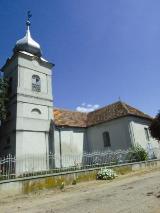Berea - The Calvinist Church
Document tools
 The church was radically transformed through the centuries, so that today only three walls are still standing from the medieval period. The importance of the church as a monument increased in the last few years, after the discovery, on the northern wall of the nave, of a fresco fragment with the image of the Holy Virgin. The fragment represents the Holy Virgin with hands joined together for prayer, surrounded with four angels. Two of the angels are setting a crown on the head of the Holy Virgin, while the other two are holding her cloak. The cloak covers a number of believers praying on their knees at the feet of the Holy Virgin. According to their clothes, the characters belong to different social strata. The fragment is dating from the 15th century, but it covers earlier fresco strata. The medieval sanctuary was demolished in 1733, and, a few decades later, in 1766, the church was radically transformed. The mention of the transformations is contained in the inscription on the northern wall of the nave. The earthquake of 1834 seriously damaged the church, and the repairs extended through a long period of time. The valuable elements of the church’s furniture are the crown of the pulpit, made of sweet cherry wood (1826) and the pipe organ, dated in 1859. The two bells were made in 1910 and 1925. (TSz).
The church was radically transformed through the centuries, so that today only three walls are still standing from the medieval period. The importance of the church as a monument increased in the last few years, after the discovery, on the northern wall of the nave, of a fresco fragment with the image of the Holy Virgin. The fragment represents the Holy Virgin with hands joined together for prayer, surrounded with four angels. Two of the angels are setting a crown on the head of the Holy Virgin, while the other two are holding her cloak. The cloak covers a number of believers praying on their knees at the feet of the Holy Virgin. According to their clothes, the characters belong to different social strata. The fragment is dating from the 15th century, but it covers earlier fresco strata. The medieval sanctuary was demolished in 1733, and, a few decades later, in 1766, the church was radically transformed. The mention of the transformations is contained in the inscription on the northern wall of the nave. The earthquake of 1834 seriously damaged the church, and the repairs extended through a long period of time. The valuable elements of the church’s furniture are the crown of the pulpit, made of sweet cherry wood (1826) and the pipe organ, dated in 1859. The two bells were made in 1910 and 1925. (TSz).References:
Lángi József – Mihály Ferenc, Erdélyi falképek és festett faberendezések (Pictura murală şi mobilierul din lemn pictat în Transilvania), II, Budapest, 2004, p. 12–13.
Lángi József, „A Köpenyes Mária középkori és barokk ábrázolásai a lónyai református templomban feltárt freskó ürügyén” (Aspecte privind reprezentările medievale şi baroce ale Fecioarei cu mantie, cu ocazia descoperirii frescei din biserica din Lónya), in Barna Gábor szerk. Kép, képmás, kultusz, Szeged, 2006, p. 50–64.
 Printable version
Printable version
 Send as email
Send as email
